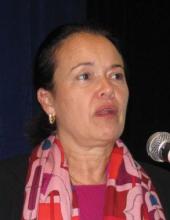SAN ANTONIO – Pathologic complete response is a strong prognostic factor in women with HER2-positive early breast cancer who receive neoadjuvant HER2-targeted therapy, investigators reported at the annual San Antonio Breast Cancer Symposium.
A team led by Dr. Martine Piccart-Gebhart, chair of the Breast International Group (BIG) in Brussels, analyzed data from 455 patients in the randomized NeoALTTO (Neoadjuvant Lapatinib and/or Trastuzumab Treatment Optimisation) trial, who received one or both HER2 therapies, along with chemotherapy.
With a median follow-up of almost 4 years, those who experienced a pathologic complete response (pCR) – meaning no detectable invasive disease in either the breast or axilla at surgery – were 62% less likely to have had events such as recurrences or second primaries, and 65% less likely to have died, she reported in a session and related press briefing.
The benefit of pCR was more pronounced among patients whose tumors were negative for hormone receptors than among their counterparts whose tumors were positive.
The new data should not change the standard of care, trastuzumab and chemotherapy, she cautioned. "But what this trial indicates to us is that it is possible that for this particular subgroup – hormone receptor–negative, HER2-positive – we could potentially use a neoadjuvant model to speed up approval of new agents. And that’s important because we know that adjuvant trials in breast cancer take forever and are very time- and money-consuming, and require thousands of patients."
Thus, the findings would lend support to the Food and Drug Administration’s use of pCR as the bar for accelerated approval of new drugs for this patient subgroup, she said.
Event-free and overall survival did not differ significantly according to the specific HER2 therapy received, although dual therapy tended to have an edge in patients with hormone receptor–negative tumors. However, the trial was not powered to detect moderate differences in these outcomes, according to Dr. Piccart-Gebhart.
"It is the very large ALTTO trial, with the recruitment of 8,300 women, that will provide a robust answer on the effect of dual HER2 blockade on long-term outcomes, and we expect to report these results at ASCO [American Society of Clinical Oncology] next year," she commented.
Analyses of NeoALTTO will be repeated after another 2.5 years, Dr. Piccart-Gebhart added. "It is possible that with longer follow-up, we will also see a bigger treatment effect in the hormone receptor–positive subgroup. But clearly, this trial provides further evidence that HER2-positive, hormone receptor–negative and HER2-positive, hormone receptor–positive groups are two different diseases."
Press briefing moderator Dr. Jennifer Litton of the department of breast medical oncology at the University of Texas MD Anderson Cancer Center, Houston, noted that pCR was used to gain initial approval of pertuzumab (Perjeta), another targeted therapy, in the neoadjuvant setting.
The reported data "in my opinion, show that it continues to be a very valid surrogate endpoint, and continues to [address the issue] of how we can develop new drugs, get them to patients quicker, with a smaller number of patients involved and less cost," she said.
Session attendee Dr. Steven E. Vogl, an oncologist in New York, asked whether pCR should be abandoned as a surrogate marker for the hormone receptor–positive subset. "It looks like the benefit of pCR was, at best, tiny in your study for those women, and probably we should think twice about using pCR in deciding which therapy is better – we should wait for event-free and overall survival. What do you think?"
Dr. Piccart-Gebhart replied that a meta-analysis of HER2 neoadjuvant therapy performed by the FDA with a much longer follow-up did find a benefit of pCR in the hormone receptor–positive subset. "It was less striking, but it was there. So I think that we have to be cautious because NeoALTTO is still a relatively small study.
"But I would tend to agree with you that the data look a lot stronger in the hormone receptor–negative subgroup, and there, based on the results I showed today, I feel confident that you could use the neoadjuvant model for accelerated approval of new drugs," she added. "For the hormone receptor–positive patients, I’m a little bit more cautious. I think these are slow actors. The events come later; you need a longer follow-up. And then of course the endocrine treatment is important and you give it after surgery in all these trials, which could be a mistake."
In the NeoALTTO study (also known as BIG 1-06), women with HER2-positive early breast cancer measuring at least 2 cm were randomly assigned to 18 weeks of neoadjuvant therapy with dual HER2 blockade using both lapatinib (Tykerb) and trastuzumab (Herceptin), or single HER2 blockade with one of the agents alone – each given along with paclitaxel.


